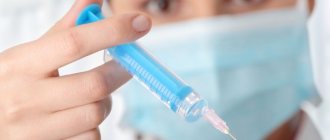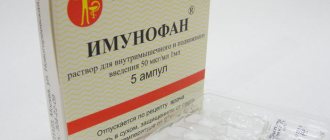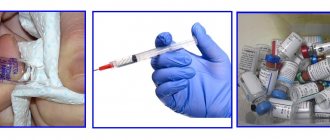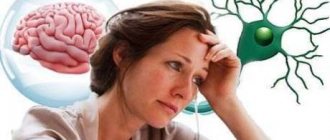CAFFEINE
(
Coffeinum
; synonym:
Cafeine, Caffeine, Coffan, Guaranin, Kaffein, Koffein, Kofka, Theinum
; GFC, sp. B) is a psychostimulant and analeptic. A purine alkaloid found in coffee seeds, tea leaves, South American paulina (gaurana) fruits, West African kola nuts, cocoa beans and sea onion bulbs.
1,3,7-Trimethylxanthine; C8H10N4O2-H2O:
CAFFEINE
White silky needle-shaped crystals or white crystalline powder, odorless, bitter taste. It erodes in air and sublimes when heated. Slowly soluble in water (1: 60), easily soluble in hot water and chloroform, slightly soluble in alcohol, very slightly soluble in ether.
The source of industrial production of potassium from plant materials is tea production waste (tea dust, bush trimmings from tea plantations, etc.) or coffee beans. Semi-synthetically and synthetically, K. is obtained from cyanoacetic acid or its esters by condensation with urea (to obtain theophylline); uric acid is also used as a starting material for obtaining K.
K. is well absorbed by different methods of administration and is distributed fairly evenly in the tissues of the body. The duration of action of K. after a single administration is approx. 6-7 hours. Biotransformation of K. occurs primarily through demethylation. Ch. is excreted from the body in the urine. arr. in the form of metabolites (mono- and dimethyl xanthines, urea); OK. 8% of the drug is excreted unchanged.
The main pharmacological property of K. is its stimulating effect on c. n. pp., especially on the functions of its higher departments. K. facilitates perception, accelerates the course of associative processes, improves the functions of the sensory organs, increases motor activity, mental and physical. performance, reduces fatigue and drowsiness. In the laboratory of I.P. Pavlov, it was first established that K. enhances and regulates excitation processes in the cerebral cortex. Under the influence of K., the excitability of the spinal cord, respiratory and vasomotor centers increases. According to the effect on c. n. With. K. is an antagonist of hypnotics and anesthetics. It is assumed that the stimulating effect of K. in relation to c. n. With. is carried out mainly by increasing the sensitivity of central catecholaminergic receptors. It has also been established that K. inhibits phosphodiesterase and thereby promotes an increase in the level of cyclic AMP in cells, and stimulates the release of calcium ions from the sarcoplasmic reticulum, which is accompanied by an increase in cell excitability. The effect of K. during skeletal muscle fatigue is associated not only with the release of intracellular Ca2+ ions, but also with their sensitization to potassium ions and the cholinergic mediator.
K.'s effect on blood circulation is not clear. During collapse and shock, K. increases blood pressure due to stimulation of the vasomotor center and the associated constriction of the blood vessels of the internal organs. Under normal blood pressure, it does not cause significant changes in its level, since simultaneously with stimulation of the vasomotor center, blood pressure has a direct vasodilating effect on the vessels of skeletal muscles, brain, heart and kidneys. K.'s heart activity increases. Like other methylxanthines, K. slightly increases diuresis by reducing tubular reabsorption of electrolytes, and also has a stimulating effect on gastric secretion.
Apply
K. as a stimulant for mental and physical. fatigue. As part of drinks (tea, coffee), K. has become widespread as a “household” stimulant of c. n. With. As an analeptic, K. is used for insufficiency of the cardiovascular system, respiratory depression, as well as for poisoning with anesthetics and other substances that depress c. n. With. In addition, K. is used to treat neuroses (often in combination with bromides) and for migraines.
Prescribe K. orally at 0.05-0.1 g 2-3 times a day. Higher doses for adults: single 0.3 g, daily 1 g. Children under 2 years of age are not prescribed K. Children over 2 years old, depending on age, are prescribed 0.03-0.075 g per dose.
K. contraindicated
with increased excitability, insomnia, severe hypertension and atherosclerosis, organic diseases of the cardiovascular system, in old age, with glaucoma.
In acute poisoning, agitation, tremors of the limbs, dizziness, vomiting, increased heart rate and breathing are observed; in severe cases, tetanic convulsions and coma develop. As antagonists in acute poisoning C., agents that inhibit c. are used. n. With. (e.g. sleeping pills, anesthetics).
Abuse of K. and drinks containing it can lead to the development of drug dependence syndrome and addiction.
Release form:
powder. K. is also included in combination tablets - askofen, caffeamine, novomigrofen, novocephalgin, pyramein, citramon, etc. K. and its preparations are stored in well-closed containers.
In addition to K., in honey. Caffeine-sodium benzoate is also used in practice
(
Coffeinum-natrii benzoas
; syn.
Coffeinum natrio-benzoicum
; GPC, sp. B), which is similar in pharmacology, properties and use to K., but is more soluble in water and is more quickly excreted from the body.
Caffeine sodium benzoate is prescribed orally at 0.1-0.2 g 2-3 times a day and under the skin at 1 ml of 10 or 20% solution. Depending on age, children are prescribed 0.025-0.1 g orally per dose, and 0.25-1 ml of 10% solution subcutaneously. Higher doses for adults orally: single 0.5 g, daily 1.5 g; under the skin: single dose 0.4 g, daily 1 g.
Release forms:
powder, tablets of 0.1 and 0.2 g (for adults) and 0.075 g (for children); in ampoules of 1 ml of 10 and 20% solution and in syringe tubes of 1 ml. It is also included in combination tablets - ankofen, diaphein, cofalgin, etc. Caffeine-sodium benzoate is stored in a well-closed container.
What is caffeine?
Caffeine is a substance that is found naturally in the leaves and seeds of many plants.
Man also learned to create an artificial analogue, the formula of which is C8H10N4O2, and use it in food. Caffeine has medicinal properties and is used as a stimulant of the central nervous system, causing increased activity. Most people respond to this substance with increased energy and improved mood.
Caffeine is found in tea, coffee, chocolate, various soft drinks, and is also part of painkillers. Natural caffeine has a bitter taste, but in many products this bitterness is masked by processing.
Content:
- What is caffeine?
- Metabolism
- Effect on the body
- Caffeine overdose
- How does it get into the blood?
- Caffeine and pregnancy
- Effect on the stomach
- Side effects
- Harmful properties
- Effects of quitting caffeine
- How to safely quit caffeine
- Benefit for health
- Invigorating springs
The main sources of this substance for teenagers are energy drinks and other soft drinks. Their “work” is noticeable, as a rule, for 6 hours. True, sensitivity to caffeine is an individual indicator. Typically, the younger the person, the less of the substance is needed to feel its effects. Individuals who regularly consume caffeinated beverages become less sensitive to this energizing component over time. This means that they will need to increase the dose again and again to achieve the effect.
Indications for use of Caffeine
In ampoules and tablets, Caffeine is prescribed for decreased mental and physical performance, for headaches of vascular origin, migraines, and infectious diseases.
It is recommended to take Caffeine Sodium Benzoate for moderate arterial hypotension, drowsiness, enuresis, respiratory depression in newborns resulting from asphyxia, poisoning with opioid analgesics, hypnotics, carbon monoxide.
In surgical practice, the drug is used to restore the required level of pulmonary ventilation.
Caffeine is used in ophthalmology for decreased tone after surgery on the organs of vision, as well as for retinal detachment.
In cosmetology practice, a mixture of Caffeine and Capsicam is effectively used for wrapping procedures.
Metabolism
Once in the body, caffeine is metabolized into dimethylxanthine derivatives (paraxanthine, theobromine, theophylline), then into monoxanthine, and then into the xanthine molecule. Other metabolic products are di- and trimethyl allantoin, uric acid and uracil derivatives.
Caffeine is easily distributed in plasma, intercellular fluid and inside cells. It also circulates in extracellular adipose tissue. By the way, people who smoke metabolize caffeine faster. Also, differences in the speed of the process may occur among people of different nationalities, which is explained by a genetic factor. But there is practically no difference in the rate of absorption between women and men.
Our body is able to absorb these “energizing molecules” quite quickly. But it also quickly gets rid of them. Caffeine is metabolized primarily by the liver and has a relatively short half-life. Usually 5-7 hours are enough to get rid of half of the resulting substance. For this reason, the cup of coffee you enjoyed before lunch will definitely not prevent you from falling asleep in the evening.
Caffeine can be synthetic or natural (obtained from plants). It is possible to determine the difference between them only in the laboratory. The concentration of any of these substances in the body can be measured by examining saliva, since this substance accumulates primarily in liquids in the body. Caffeine can enter the body through the mucous membranes of the cheeks. Chewing gum containing the substance is characterized by faster absorption compared to drinking coffee, since in the form of a drink, caffeine must first pass through the stomach and intestines, and only then enters the blood.
Effect on the body
Caffeine is a product of plant origin, the highest concentration of which is found in coffee beans, tea leaves, soft drinks, chocolate, and cocoa beans.
Also found in some medications (painkillers, allergies, colds and weight loss). In fact, from a chemical point of view, caffeine is a pain reliever and also a substance that enhances the effects of other pain-relieving drugs.
Modern data on caffeine is very contradictory regarding its beneficial and negative effects on the human body.
It is believed that for healthy people, 300 mg of an invigorating substance per day is a normal portion that is not harmful to health. Meanwhile, in some cases it is important to limit the consumption of the substance. Large portions (more than 700 mg per day) help remove calcium and magnesium from the body. It was previously believed that caffeine was one of the causes of osteoporosis. Meanwhile, recent studies have shown that calcium losses caused by caffeine from 1 cup of coffee can be easily compensated for by 2 tablespoons of milk. But in people who are especially sensitive to even minor calcium losses, caffeine can actually cause bone problems. For this reason, women after menopause should not abuse caffeine-containing products, since they are already at risk of developing osteoporosis.
It also acts on the body as a mild diuretic. But again, don't worry that foods containing this substance can cause dehydration.
When talking about caffeine, many people think of coffee first. But this is far from the only source of the substance. Tea, cola and other drinks also contain caffeine. And this explains why, according to research, children aged 6-9 years consume approximately 25 mg of the energizing substance daily, and their parents may not even realize it. Meanwhile, children sensitive to it develop irritability and anxiety.
Caffeine acts as a stimulant, affecting the central nervous system. In the body, this substance begins to act approximately 15 minutes after administration and this effect lasts up to 6 hours.
Caffeine - interaction with other medications
Caffeine potentiates (increases the effect) the effect of many drugs: • Barbiturates • Anticonvulsants • Pyramidon
Ciprofloxacin and nofloxacin, oral contraceptives, cementedin reduce the absorption of caffeine and its processing by the liver.
When drinking drinks containing an additional dose of caffeine, high stimulation of the central nervous system can occur. The drug "Mexiletine" reduces the process of removing the drug from the body, while nicotine, on the contrary, promotes the rapid elimination of the drug.
When consuming caffeine, calcium medications may not be absorbed into the gastrointestinal tract.
Caffeine is an antagonist of the drug adenosine, and therefore is an “antidote” for its overdose.
Caffeine overdose
Consuming moderate doses (up to 250 mg of brewed coffee or 500 mg of cola) helps people concentrate and relieve drowsiness. But higher doses increase heart rate, raise body temperature, increase blood flow to the skin and extremities, increase blood pressure and blood sugar levels, and also stimulate the secretion of stomach acid, acting as a diuretic.
With excessive consumption of the substance, people may experience dizziness, hypoglycemia, nausea, rapid breathing and heart rate, confusion, irritability, insomnia, changes in appetite, dry mouth and other side effects. But contrary to popular belief, caffeine cannot neutralize alcohol in the body.
How does it get into the blood?
Once in the body, caffeine is absorbed in the intestines by almost 99%. And the concentration of the substance in the body can reach up to 10 mg per 1 kg of weight. The entire absorption process occurs within approximately 45 minutes after ingestion, and caffeine reaches its peak level in the blood within 15-20 minutes. But these are rough estimates, since in each case the rate of absorption of substances depends on physiology and the source. Caffeine is absorbed slowest from chocolate and cola, while caffeine from coffee drinks and substances in tablet form is absorbed faster. But still, it is absorbed most quickly from chewing gum - through the mucous membranes of the oral cavity.
Additional Information
During therapy, it should be taken into account that the drug enhances the effect of sleeping pills and narcotics, aspirin, paracetamol and other non-narcotic analgesics.
With the simultaneous use of caffeine with drugs that contain mexiletine, there is a deterioration in the process of removing caffeine from the body. The simultaneous use of this medication with nicotine increases and accelerates its elimination.
Caffeine in all forms must be stored in a dark, cool place out of the reach of children. The shelf life of the drug is 60 months.
Side effects
Consuming caffeine in moderate doses generally does not have any harmful side effects on the body. Although some researchers convince that regular consumption of 100 mg of coffee daily can subsequently cause infertility, heartburn and intestinal dysfunction.
Consuming high doses of caffeine deprives you of sleep, and a person stops noticing the body's signals about the need for rest. Meanwhile, it is important to understand that caffeine does not replenish energy reserves or prevent emotional fatigue. It simply blocks the body's physiological needs for rest. Over time, this condition leads to the development of depression, causing anxiety, excessive nervousness, sweating and tremors.
Harmful properties
Some studies suggest that caffeine may be harmful to your health. Here are some arguments in favor of this.
- Consuming more than 4 cups of coffee per day leads to early death. Research shows that this dose, taken daily, is enough to increase the risk of sudden death by 21%.
- Increases blood pressure. In people suffering from arterial hypertension, after 2 cups of coffee, blood pressure rises over the next 2-3 hours.
- Increases the risk of cardiac diseases at a young age. Drinking 4 cups of coffee daily is enough to quadruple your risk of heart attack.
- Caffeine can trigger the development of gout.
- Provokes the formation of cysts in the mammary glands in women. It is enough to consume 30 mg of coffee per day to increase the chances of fibrocystic mastopathy by one and a half times. And women who drink 500 mg of coffee are 2-3 times more at risk of cystitis.
- Causes urinary incontinence. People who consume the drink regularly and in large doses are 70% more likely to experience incontinence than others.
- Causes insomnia.
- Causes stomach upset. Especially if you drink coffee on an empty stomach.
- Excessive caffeine consumption provokes headaches.
- Caffeine leads to impaired fertility in women: the chances of getting pregnant are reduced by 27%.
- The risk of miscarriages increases: it is enough to drink 2 servings of coffee daily for several weeks before conception.
- It worsens the health of diabetics because it disrupts glucose metabolism.
- May cause overdose or allergy symptoms.
- Accelerates heart contraction.
- Exacerbates the symptoms of menopause.
- Increases anxiety and depression.
- Caffeine lovers consume more glucose, which is fraught with obesity and diabetes.
- It suppresses collagen production in the skin.
- Makes bone tissue more fragile, which increases the risk of fractures.
"Caffeine" in tablets, ampoules, drops - dosage
The dose for different forms of release and for different diseases varies:
- For the injection route of administration subcutaneously, it is recommended to use adults from 100 to 200 mg 2 or 3 times a day (or 1 ml of 10-20% solution), and children from 25 to 100 mg 2 or 3 times a day (0.25 -1 ml 10% solution)
- For the tableted form of release, the doses are as follows: adults from 50 to 100 mg 3 times a day, for children the average dose is recommended at 30 or 75 mg 3 times a day.
- When indicated in ophthalmology, a 10% solution of 0.3 ml is administered subconjunctivally once a day.
It is not recommended to take the drug before bedtime.
Effects of quitting caffeine
People who stop drinking caffeinated drinks may experience discomfort and deterioration in the first 12-24 hours. Typically, the first side effects of caffeine withdrawal include headaches, irritability, nausea, nervousness, and muscle tension. But these symptoms last no longer than a week. Then the body finally adapts to a new way of life.
In order to avoid side effects, experienced people advise switching to a caffeine-free life gradually - reducing the amount of substance consumed every day.
How to safely quit caffeine
Try drinking plain water instead of cola first. Stick to this principle for a week. Have your caffeine cravings decreased? This means that the “treatment” must be continued. Now is the time to replace traditional coffee with a similar decaffeinated drink. It is also important to track portions of food consumption. Continue until your daily caffeine dose drops to 100 mg or less. Gradually giving up caffeine-containing drinks will protect you from unpleasant physiological sensations and will also be less “painful” on a psychological level.
Without caffeine, do you feel tired? Make sure you are getting enough rest per day? Better yet, check the vitamin and mineral balance in the body? Drowsiness and chronic fatigue may indicate vitamin deficiency or other health problems. But caffeine does not cure this.
Children and adolescents - it is better to abstain
There is clearly insufficient data on safe doses of caffeine for children and adolescents. According to European experts, 3 mg/kg of body weight per day will not harm young consumers. In Canada, a dose of no more than 2.5 mg/kg/day is considered safe. In accordance with these standards, children, depending on age, are allowed to:
- 4-6 years - 45 mg/day
- 7-9 years - 62.5 mg/day
- 10-12 years - 85 mg/day.
Not everyone agrees with this opinion. Thus, in 2013, a group of distinguished American doctors sent a letter to the US Food and Drug Administration calling for a ban on the sale of caffeinated drinks in schools. Scientists note that energy drinks are reliably correlated with adverse health effects in children, adolescents and young adults.
So the safe level of caffeine for children and adolescents has been determined, but some medical organizations are calling for more thorough research into this problem, and until data is collected, the less caffeine a child consumes, the better.
Benefit for health
People who regularly consume caffeine (in adequate doses) report improved concentration and cognitive function. For some people it is a remedy for headaches.
According to some data, it can reduce the risk of Parkinson's disease, liver disease, dementia, and type 2 diabetes. But despite the possible positive effects, do not forget that consuming this substance in large doses can have adverse effects.
In addition, caffeine tablets serve as a cure for migraines. Take 1-2 tablets for a week, and then 1 tablet for a month. It also has benefits for bodybuilders, as it helps increase performance by almost 20%. Bodybuilders consume approximately 3 mg of the substance for every kilogram of body weight half an hour before a planned workout.
By the way, depression of the central nervous system, decreased activity (physical and mental), a state close to loss of consciousness, cerebral vascular spasms (migraine), hypotension and asthma can also be reasons to drink a cup of coffee or a tablet containing caffeine. Even infants are also prescribed this substance as a medicine for certain diseases.
Advantages:
- Reduces pain. Two cups of coffee can reduce post-workout pain by 48%.
- Source of fiber. Two cups of brewed coffee provides 1.8 g of fiber.
- Protection against diabetes. Coffee drinkers (1 cup per day) have a 9% lower risk of developing type 2 diabetes.
- Immunity from Alzheimer's. There is an assumption that caffeine can protect against the development of Alzheimer's disease.
- Cure for depression. A 10-year study involving 86 thousand women showed that coffee drinkers were 20% less likely to suffer from depression.
- Protection against Parkinson's. Researchers from Sweden claim that caffeine reduces the chances of developing Parkinson's disease. Incredibly, scientists suggest that this substance can even affect the genetic factor.
- Protection against cardiac diseases. This generally sounds like science fiction, since traditional medicine prohibits people with heart problems from consuming caffeine. But Korean researchers say 3 cups of coffee a day improves health and reduces the chances of heart disease.
- Stronger DNA. The European Journal of Nutrition once reported that the DNA of coffee drinkers is more stable and without damage. They say that this is again due to caffeine.
- Less chance of multiple sclerosis – 4 cups of caffeinated beverage per day can protect against multiple sclerosis, preventing neuronal damage that causes the disease. At least that's what researchers from Sweden think.
- Reduces the risk of cancer. Moderate caffeine consumption reduces the risk of colon cancer by 26%. This was stated by scientists from California after a study involving 5,100 people. And another group of scientists from a cancer center in Southern California noticed that coffee drinkers were 29% less likely to get liver cancer.
- No gout. A study involving more than 50 thousand people allowed scientists to conclude that coffee protects men from gout. It is believed that this is the “work” of caffeine. Although no one can give a 100% guarantee of this yet. Moreover, there is a completely opposite opinion that it is precisely this that causes gout.
In addition, some experiments have shown that caffeine can stimulate sexual desire in women, protect against early death (according to Japanese scientists), prevent tooth decay, retinal damage and even melanoma.
Harm and contraindications
The harm of caffeine depends on the dosage and the condition of the body. If a person is healthy, then the substance will only have a positive effect. It will also help get rid of some problems. But if you abuse caffeine-containing products, negative consequences will not keep you waiting.
It's no secret that this substance is addictive. It stimulates the release of the hormone dopamine and suppresses fatigue. Therefore, abruptly stopping caffeine consumption can cause withdrawal symptoms.
Many people feel nervous and tired in the morning until they drink their treasured cup of coffee. This is a manifestation of the so-called “coffee mania.” To get rid of this addiction, you need to gradually reduce the dosage.
So why is caffeine harmful?
- It reduces the absorption of calcium in the body. Due to frequent consumption of caffeinated drinks, the acid-base balance in the stomach is disturbed. The degree of absorption of nutrients decreases, so the body is forced to compensate for the lack of calcium by borrowing it from the bones. Over time, this can lead to osteoporosis (brittle bones).
- Due to the strong diuretic effect, dehydration occurs.
- strong stimulation of the nervous system causes sleep disturbance and increases irritability.
- in large doses it causes surges in blood and eye pressure, which is especially dangerous for older people.
- Contraindicated for diseases of the cardiovascular system. It has a particularly depressing effect in combination with alcohol and cigarettes.
- Due to the constant stimulation of gastric secretion, problems with the gastrointestinal tract arise, and people with high acidity should not use it at all.
- Constriction of blood vessels in the brain leads to insufficient blood flow, which contributes to early aging.
- Excessive caffeine consumption by men harms their sexual health and potency. A decrease in erection occurs due to the action of plant estrogens, a small amount of which does not pose any danger.
You should be careful when consuming caffeine-containing products during pregnancy, because their effects also affect the baby. The fetus's heart rate and metabolism increase, which can negatively affect its health.
Some time ago it was believed that caffeine provokes the development of cancer. But modern research has refuted this information.
Thus, a large concentration of this substance has a depressing effect on the body. Only moderate consumption will help you avoid negative consequences and benefit.
Overdose
Large amounts of caffeine have a negative impact on physical health and can even be fatal. People with cardiovascular diseases and high blood pressure should be especially careful.
It is believed that 10 g of this substance is a lethal dose. You can get it by drinking 70 cups of coffee in a row. However, people suffering from “coffee addiction” receive about a tenth of this amount.
Symptoms of the negative effects of caffeine on the body:
- arrhythmia,
- strong increase in pressure,
- irritability,
- insomnia
- increased excitability.







